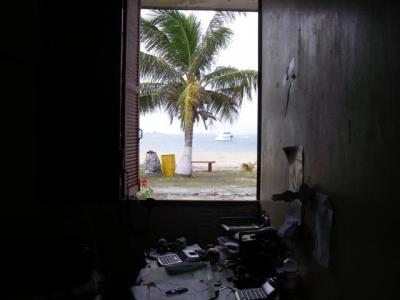From the outside, the office looks like a nice looking bungalow. Inside it is unfinished. While the concrete frame is structurally sound, there is still a long way to go before the construction will be done. Electric cables have been run through the building, but things like light switches and plugs have not been put it. There is no ceiling yet. The back door was broken and so tattered that only a few beams of wood were left on it. It didn’t look like there was any lighting installed yet, but there was plenty of natural light.
The three officials were all housed in the same little building, which made finding them easy. All were dressed in casual western wear and are pleasant people. We asked the immigration officer where the airport was and he told us that the airport is “broken right now”. Needless to say, with no electricity, there were no computers and all paperwork was done by hand. The paperwork process was slow, particularly with the port authority officer who issued our cruising permit. The check in fees were $96.00, and there are some check out fees, so Panama is one of the more expensive countries we have visited in terms of administrative costs. It took a full hour for the three stops. We didn’t mind. We were happy to be on solid land. We’d say the port authority officer has a nice view from his office.

Several sets of boaters arrived after us, and got in line behind us. We can’t imagine how long it will take the people in line to get through. The German guys were first in line behind us and we started talking to them. It turns out that they also came from Bonaire, leaving the same day we did. Then one of them put two and two together and said “you’re the pirates!” It turns out these were the guys we were running parallel with last night. They had the opposite reaction to us as we did to them. When they first saw us, they thought we were fishermen and disregarded us. But when they realized we had been running parallel for over several hours, they got more and more worried that we were pirates looking for a good spot to attack. They shut off their lights and changed coarse to get away from us. They said we were very nice pirates.
After we were done, we Continue reading
